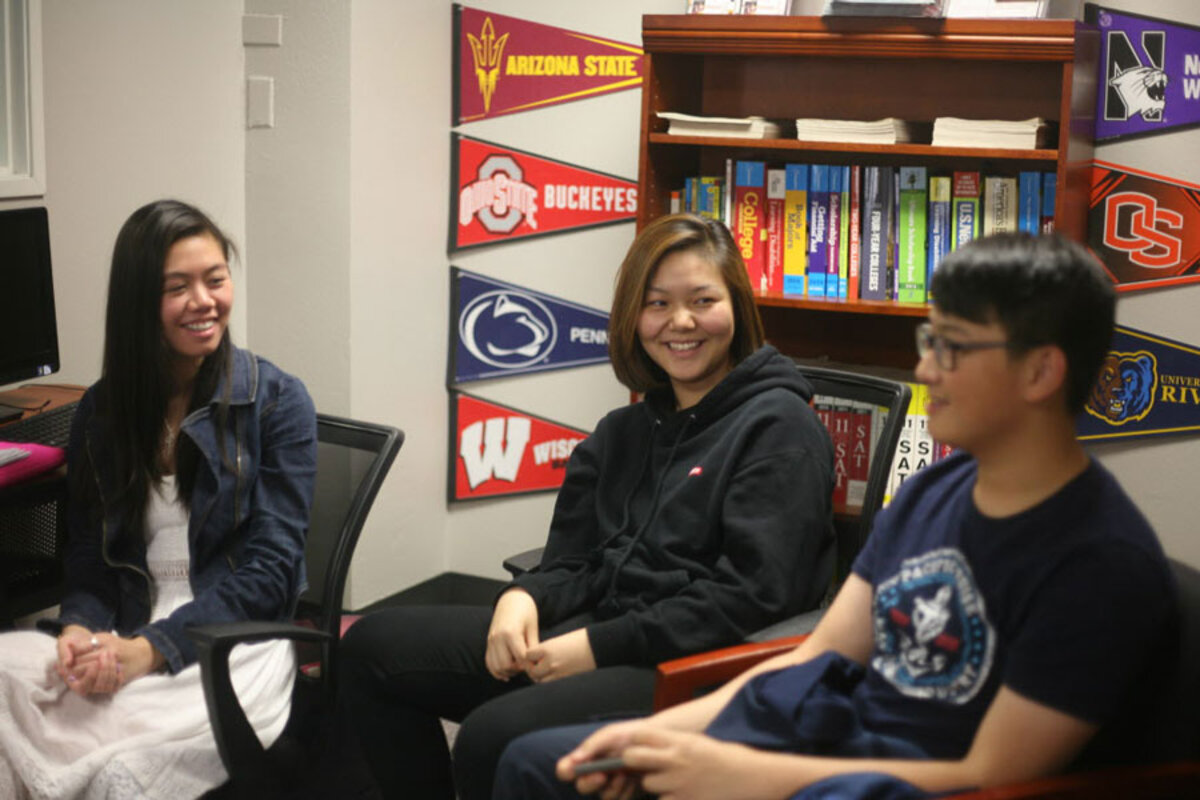How international students are changing the 'rich Asian' narrative
Loading...
| ARCADIA, Calif.
On the West Coast, the image of the Chanel-clad, Lamborghini-driving Chinese scion has fueled stereotypes and reality shows such as ãUltra Rich Asian Girls.ã
But the three international students sitting in the conference room at Arroyo Pacific Academy donãt wear designer labels or drive supercars. In fact, only one comes from mainland China.
And they are part of a wave of immigration that often gets overlooked in the hyperbolic political debate that has marked the 2016 election: middle-class immigrants in search of an education.
Although ultra-rich families ã mostly from mainland China ã continue to send their children to college in the US, data suggest that the latest waves of international students arriving for a Western education look more like Estefany Wu, Lavinia Siqin, and Vincent Liu: well-to-do, but not excessively so; of diverse, though still mainly Asian, origins; and below college age.
ãIãm middle [class], upper-middle, maybe,ã says Estefany, a high school senior who moved to the United States in 2013 from Mexico City, where her parents own a string of Chinese restaurants. ãYeah, same,ã Lavinia, a soft-spoken junior from Chinaãs Sichuan province, chimes in.
The reason: Expanding economies in China, Vietnam, South Korea, and Taiwan, among others, have increasingly enabled middle class families to afford to send a child to study overseas. Indeed, the number of international students enrolled in US high schools tripled between 2004 and 2013, .
ãYears ago, when international mobility was an elite phenomenon, [studying abroad] was seen as something that only the well-off could afford,ã says Rajika Bhandari, the organizationãs deputy vice president of research and evaluation.
ãBut an increasing number of international students avail of student loans in their home countries. And many Chinese families ãÎ theyãve been saving for many, many years,ã she adds. ãAlthough a family may be paying for an education [overseas], thatãs not necessarily an indication of affluence.ã
Fierce competition for college placement in their home countries, and the relative ease with which international students can enter the US at the middle and high school levels, also have parents sending children at younger ages halfway across the globe for a shot at what they consider a world-class education.
In China in particular, ãthe education system is such that it is very competitive,ã notes Min Zhou, a professor of sociology at the University of California, Los Angeles, who specializes in international migration. The pressure of the dreaded ãgaokaoã ã a grueling two-day exam that determines a Chinese high school seniorãs college placement ã has motivated more families to send their children abroad before senior year. ô
ãThat educational fever becomes a culture for parenting,ã Professor Zhou says. ãSo the age of coming to the US for schooling is younger and younger.ã
ãA lot of these students are very interested in ultimately enrolling in a US college or university, and they see being able to obtain a credential at the high school level as a way to ease their path into a US higher education program,ã Bhandari adds.
Immigration concerns in the Golden State and nationwide have long focused on lower-income immigrants, who supposedly are taking jobs from Americans (), and the ultra rich, who are allegedly pricing Americans out of urban housing markets. But the tide of out-of-state and international students has also raised questions about whether or not they are crowding out in-state applicants from California's state university system, particularly its prestigious UC-Berkeley campus.ô
In March, an audit requested by a California congressman accused the University of California of hurting local students by admitting too many out-of-state applicants and recommended a cap on enrollment and stricter entrance requirements for nonresidents, among other steps. UC President Janet Napolitano called the findings ãunfair and unwarranted,ã the . She said that the $728 million brought in by higher-paying out of state and international students allowed the 10 campuses to accept more Californians in the face of state budget cuts since the recession.
Between fall 2008 and fall 2015, enrollment of out-of-state students grew from 9,000 to 30,907, according to UC figures. At the same time, California undergraduate enrollment increased from 163,773 from 167,959.
An alternate experience
Arcadia, a suburb in the San Gabriel Valley just east of Los Angeles, has long been a hub for immigrants out of China and Taiwan; of the population is Asian, according to the latest US Census data.
In the past decade, the cityãs existing Chinese community drew in new arrivals, many of whom used their nationãs growing wealth to take part in the United Statesã EB-5 program, which fast-tracks the permanent residency or green card process for foreigners who invest between $500,000 to $1 million in job-creating businesses here.
The wave of wealthy newcomers led to a crop of McMansions sprouting across Arcadia ã rows of eight- or nine-bedroom homes built behind wrought-iron gates and emerald-green lawns. The trend solidified the cityãs reputation as .
Yet the international students who have lately found their way to the San Gabriel Valley and Arcadiaãs school system bring a somewhat different perspective.
ãI really only come here to get better education,ã says Lavinia. ãAfter I graduated from middle school, I got the opportunity. And because my grandpa works here, my parents think that they can send me here and somebody will take care of me.ã
Sheãs not yet sure what she wants to pursue after high school, but Lavinia says she might major in business and follow in her fatherãs footsteps ã he works in the propane gas industry in China. She might also major in the arts, as her mother expects of a young woman.
Estefany, the senior, was at first doubtful about studying in the US.
ãI was questioning whether I made the right choice,ã she says. But ãthroughout this year, my senior year, a lot of support has come into my life.ã She now plans to major in economics and international studies at UC Irvine when she graduates.
ãIãm pretty sure Iãm going to stay here. Have my own business, maybe,ã she says.
Mixed impact
Economics is the main selling point of those who support opening doors to international students in US high schools and universities. In the 2014 to 2015 academic year, spending among international students in higher education alone to the US economy and supported more than 373,000 jobs, according to the Association of International Educators, or NAFSA.
Thereãs much to gain culturally, as well.
ãInternational students help bring global perspectives to their classrooms and educate their US peers, especially since not all of those American students are going to have an opportunity to study abroad,ã says Bhandari at IIE.
At the same time, the international students get a taste of Western education and culture. Vincent, the Arroyo Pacific freshman, says he enjoys going to school in the US far more than he did in Taipei.
Such positive experiences could have a long-term impact on the relationship between their home and host countries, says UCLAãs Zhou, who is currently a visiting teacher at Nanyang Technological University in Singapore.
ãIf [these students] return to China, a lot of them are able to take up leadership positions. With a US degree, you can move up pretty quickly,ã she says. ãWith their exposure to the US, they could contribute to more positive US-China relations. They understand both [cultures], they had exposure to both.ãô
Yet leaving so many teenagers in the care of guardians or distant relatives can have negative consequences. Among the worst cases took place in March 2015 at an ice cream parlor in Rowland Heights, also in the San Gabriel Valley. What started as a disagreement over an unpaid restaurant bill ended with three teenage girls forcing one of their classmates ãto kneel and use her hands to wipe cigarette butts and ice cream smears off the floor,ã .
The three girls involved have since been on charges of torture, kidnapping, and assault.
Most cases are far less alarming. But living as a stranger in a strange land before one turns 18 is a still a huge challenge.
ãTheir peer groups are likely to be among themselves. They feel that because of the language and culture barrier, itãs hard to break into a native clique of circle of friends,ã Zhou says.
Estefany can relate. Her Mexican accent ã heavier when she first moved to the States two years ago did little to help her transition, she says. ãI'm a very talkative person, and when I can't communicate I get really stressed out.ã
For Vincent, high school in America offers a lot more scope for conversation.
ãIn Taiwan, there's nothing that we can do except studying,ã he says. ãYou can't really talk about your thoughts or share your experience.
ãNo one's really curious about your thoughts,ã he adds. ãAnd whenever you have questions, my classmates would just tell me, ãIf it's not going to come in the test, why would you ask this?ã That's why I want to be here.ã





